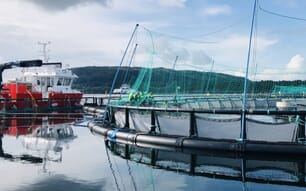Fisheries Queensland believes the parasitic flatworm may be the major cause of redness and illness in the barramundi collected from the Harbour and may have led to some of the lesions seen.
Fish samples tested from Port Alma, which is just outside Gladstone Harbour, did test positive for red-spot disease.
The Harbour fish tested by Biosecurity Queensland that showed lesions did not test positive for red-spot disease, however the symptoms of lesions were consistent with the disease. All these fish did test positive for the parasitic flatworm (fluke).
Fisheries Queensland believes that the estimated 30,000 barramundi washed over the spillway at Awoonga Dam between December 2010 and March 2011 due to overtopping has contributed significantly to the number of fish seen with symptoms.
This represents an additional 300 tonnes of barramundi introduced into the Boyne River and Gladstone Harbour, which is reflected in the dramatically increased catches of barramundi by commercial fishers during this year. The average annual catch rate is normally 9.88 tonnes, but this year it’s jumped to approximately 197.5 tonnes so far.
Fisheries Queensland's hypothesis is that fish suffered physical stress, which combined with the stress of the relocation, would have also made them susceptible to disease.
The addition of so many large barramundi in the Boyne River below the dam would have significantly increased competition for food and increased physical stress levels of all fish.
The likely significant increase in stress levels has lowered the ability of fish to tolerate these parasites on their skin. As a result, the fish attempt to remove them by rubbing against hard objects, causing the redness.
In severe cases the redness may become an open wound (lesion), which can attract secondary infections.
Further targeted sampling and testing seeks to confirm the status of fish health and relationship between the parasite and the redness.
Mud crabs and prawns submitted for testing all had evidence of erosion consistent with shell disease that does occur occasionally.
Fisheries Queensland will continue collecting more samples of barramundi and other fish for testing and will make the results of those tests publicly available.
The sampling over coming weeks will be collecting information from a number of sites in the following four areas:
- tidal reaches of Boyne River (noted sites of highest lesion/eye and skin parasite infection)
- tidal reaches of Calliope River
- sites around Hamilton Point as previously sampled
- a site outside the Gladstone Harbour.
The closure was lifted as we had identified the likely causes of the symptoms, and Queensland Health could not find any association with fish disease and human health concerns, and symptoms identified in the sick fishers.
The identification of likely diseases producing the symptoms led Queensland Health to determine that there was no risk to human health or unsafe food, providing safe food procedures are followed.




